AI-Based Computational Model in Sustainable Transformation of Energy Markets
Abstract
:1. Introduction
- transition to low-emission energy production and a decentralized system for more efficient energy distribution;
- energy exchange modeling;
- creating algorithms for the local energy market;
- development of energy exchange models with flexible data entry or deterministic price patterns;
- achieving competitiveness of combined heat and power plants and energy feedback devices;
- qualitative and quantitative comparison of different models [15].
- It must operate on the territory of a rural or urban-rural municipality as defined by the law on public statistics or on the territory of no more than three directly neighboring municipalities of this type;
- If the object of its activity is the production of electricity, the total capacity of all RES installations, e.g., PV or wind power, must be able to cover at least 70% of the annual demand of the energy cooperative and its members and must not exceed 10 MW (the last amendment to the RES Act reduced this value to 40%);
- If the object of its activity is the production of heat, the total thermal power output does not exceed 30 MW;
- If its object is the production of bio-gas, the annual production capacity of all installations does not exceed 40 million m3;
- An energy cooperative, like prosumers, cannot dispose of energy today, but only feeds it into the grid;
- Surpluses can only be stored (surrendered) in the grid and the operator will deduct 40% of the volume from this (1:0.6).
- Lower energy price—EC members themselves determine the price at which they will settle based on the adopted EC statute;
- Contracts for the sale and purchase of energy are multi-annual, ensuring stability and predictability of both revenues and costs over the long term;
- By using local fuel resources and the local grid, security of supply is increased;
- Environmental pollution is reduced due to the use of mainly RES;
- The attractiveness of the EC area for investors is increased due to the availability of cheaper and environmentally friendly energy.
1.1. The Problem of Analyzing a Dataset on the Billing of Energy Cooperatives
1.2. Tools for Designing Energy Cooperatives—The Need to Use Artificial Intelligence
- Modelling of daily/hourly balance and aggregated to month and year level;
- Setting self-consumption levels;
- Use of different types of generation sources;
- Mapping of actual, different generation profiles;
- Mapping of the actual different consumption profiles;
- Illustration and visualization of results.
- Current and projected costs (levelized cost of electricity—LCOE);
- Current and projected market price levels for energy;
- Parameters determining the productivity and efficiency of generation sources;
- Generic structure of investment and operating costs.
- Forecasting of energy supply, demand, and prices, continuous energy balancing for members of the energy cooperative;
- Integration in a distributed block register of energy flows read from meters, sub-metering devices or from DSO databases for evidence, billing, and balancing control purposes;
- 1 min monitoring of the state of selected elements of the power grid at set time intervals and alerting on threats or situations requiring human intervention;
- Analysis of the operation of electricity and heat storage facilities as a tool for optimal energy balancing in energy communities.
2. Material and Methods
2.1. Data Set
- Current weather (air temperature (°C), wind speed (m/s), cloudiness (five classes represented by numbers));
- Weather forecast (air temperature (°C), wind speed (m/s), cloudiness (five classes, e.g., cloudy represented by numbers));
- Power (Watts);
- Current power direction (four classes represented by numbers);
- PV use (Watts);
- Power network use (Watts);
- Energy storage status (%);
- Energy consumption by receivers (Watts);
- Standardized power (%);
- Energy balance (Watt/hour);
- Income (PLN) (daily, monthly, yearly, total);
- Total CO2 reduction (tons), including equivalent number of trees or car use (km).
2.2. Computational Tools
- Linear regression;
- Non-linear polynomial regression;
- Traditional neural networks: multilayer perceptron (MLP);
- Deep neural networks: convolutional neural network (CNN).
- Task complexity;
- Time constraints;
- Available resources;
- Desired level of customization;
- Desired accuracy.
- f—activation function,
- x—network inputs,
- y—network outputs,
- Ѳ—set of parameters mapping input x to an output class y,
- f(x)—output of network,
- f1(x)—output of 1st layer,
- f2(x)—output of 2nd layer,
- f3(x)—output of 3rd layer.
- y—output,
- W—weights,
- x—inputs,
- b—bias.
3. Results
- Digital Twin—the digital equivalent of a real process and/or device. AI makes it possible to analyze a theoretically infinite number of parameters simultaneously, thereby significantly improving the quality and safety of decision-making processes in the planned energy cooperative;
- Production optimization—the use of AI algorithms (dedicated machine learning models) to optimize the electricity production process taking into account the entire supply chain. It is also possible to coordinate in-house production and energy purchases to cover shortfalls. This measure is particularly important in the case of biogas plants, where the stability of the substrate supply guarantees the profitability of the entire operations;
- Vision AI—In practice, this involves analyzing camera images and monitoring the quality of operation of the RES equipment belonging to the energy cooperative—detecting specific situations in the operation of photovoltaic, biogas, or wind power plants. It will be of particular importance in the supervision of distributed installations on municipal sites without access to qualified personnel. Responding quickly to failures means reducing costs and increasing operational efficiency;
- Smart health and safety—AI helps to detect security breaches and incidents such as unauthorized access or mishandling of RES installations or RES-powered electric vehicles (electric chargers, hydrogen chargers);
- Behavioral analyses—using AI to predict the behavior of energy consumers (members of the energy cooperative) and reaching out to the mass market with personalized offers (promotion of self-consumption, promotion of energy consumption at specific times when energy is cheap—there is too much energy);
- Personalized offers—on the basis of data from behavioural analyses, it is possible, using artificial intelligence and, more specifically, advanced recommendation engines, to personalize offers for specific customers of energy cooperatives (different for a farmer, different for a municipality employee, different for companies). The offers can be for tariff products, but especially combined (bundles) with non-tariff products and services;
- Marketing automation—on the basis of intelligent customer segmentation, it becomes possible to more precisely prepare and enforce marketing campaigns to specific groups (members of the energy cooperative (municipal facilities, farms, companies) and to predict sales effects for new energy cooperative members.
- Three levels of energy production and consumption (Figure 9);
- Priority of own energy consumption;
- Minimisation of energy consumption.
3.1. Hyperparameters Tuning and Input Function Selection
- Number of hidden layers;
- Number of neurons in the hidden layer;
- Activation functions (sigmoid, tanh, rectified linear unit (ReLu));
- Speed of learning;
- Number of training examples in each iteration;
- Number of iterations of the entire training data set;
- Regularization (L2 or L1) used to prevent overfitting;
- Dropout rate (percentage of neurons randomly removed during learning to prevent overfitting);
- Optimization algorithm for updating model weights (Adam, RMSProp, etc.);
- Initialization of network weights (He, Xavier, etc.);
- How learning rates change over time for faster convergence;
- Architecture modifications (e.g., adding omitted connections).
3.2. Best Results and Cross-Validation
4. Discussion
- Circular economy;
- Digital transformation;
- Green competitiveness;
- Sustainable development.
4.1. Limitations of the Current Studies
4.2. Directions for Further Research
5. Conclusions
- Creation of recommendations and best practices on the use and implementation of AI solutions in the energy sector (including within energy cooperatives);
- Analysis of state-of-the-art AI algorithms and models in the energy-processing sector;
- Developing the competences of those involved—energy engineering and AI specialists;
- Sharing and exploitation of sensitive data;
- Computing power requirements and infrastructure needed to collect, share, and process data;
- Regulation: identification of legal barriers to the development of artificial intelligence in the energy sector, directions for legislative changes, analysis of legislative proposals.
Author Contributions
Funding
Data Availability Statement
Conflicts of Interest
References
- Rojek, I.; Mikołajewski, D.; Mroziński, A.; Macko, M. Machine Learning- and Artificial Intelligence-Derived Prediction for Home Smart Energy Systems with PV Installation and Battery Energy Storage. Energies 2023, 16, 6613. [Google Scholar] [CrossRef]
- Güney, T. Renewable energy, non-renewable energy and sustainable development. Int. J. Sustain. Dev. World Ecol. 2019, 26, 389–397. [Google Scholar] [CrossRef]
- Cahyadi, A.; Magda, R. Digital Leadership in the Economies of the G20 Countries: A Secondary Research. Economies 2021, 9, 32. [Google Scholar] [CrossRef]
- Baños, R.; Manzano-Agugliaro, F.; Montoya, F.G.; Gil, C.; Alcayde, A.; Gómez, J. Optimization methods applied to renewable and sustainable energy: A review. Renew. Sustain. Energy Rev. 2011, 15, 1753–1766. [Google Scholar] [CrossRef]
- Recalde, M.; Peralta, A.; Oliveras, L.; Tirado-Herrero, S.; Borrell, C.; Palència, L.; Gotsens, M.; Artazcoz, L.; Marí-Dell’Olmo, M. Structural energy poverty vulnerability and excess winter mortality in the European Union: Exploring the association between structural determinants and health. Energy Policy 2019, 133, 110869. [Google Scholar] [CrossRef]
- Usman, M.; Hammar, N. Dynamic relationship between technological innovations, financial development, renewable energy, and ecological footprint: Fresh insights based on the STIRPAT model for Asia Pacific Economic Cooperation countries. Environ. Sci. Pollut. Res. 2021, 28, 15519–15536. [Google Scholar] [CrossRef] [PubMed]
- Ibn-Mohammed, T.; Mustapha, K.B.; Godsell, J.; Adamu, Z.; Babatunde, K.A.; Akintade, D.D.; Koh, S.C.L. A critical analysis of the impacts of COVID-19 on the global economy and ecosystems and opportunities for circular economy strategies. Resour. Conserv. Recycl. 2021, 164, 105169. [Google Scholar] [CrossRef]
- Lang, B.; Dolan, R.; Kemper, J.; Northey, G. Prosumers in times of crisis: Definition, archetypes and implications. J. Serv. Manag. 2021, 32, 176–189. [Google Scholar] [CrossRef]
- Golovenchik, G.G.; He, Y. Ten drivers of the Chinese digital miracle [Desyat’ drajverov kitajskogo cifrovogo chuda]. Digit. Transform. 2021, 3, 11–25. [Google Scholar]
- Shivakumar, A.; Dobbins, A.; Fahl, U.; Singh, A. Drivers of renewable energy deployment in the EU: An analysis of past trends and projections. Energy Strategy Rev. 2019, 26, 100402. [Google Scholar] [CrossRef]
- Gielen, D.; Boshell, F.; Saygin, D.; Bazilian, M.D.; Wagner, N.; Gorini, R. The Role of Renewable Energy in the Global Energy Transformation. Energy Strategy Rev. 2019, 24, 38–50. [Google Scholar] [CrossRef]
- Hosseini, S.E. An outlook on the global development of renewable and sustainable energy at the time of COVID-19. Energy Res. Soc. Sci. 2020, 68, 101633. [Google Scholar] [CrossRef]
- Avelino, F.; Wittmayer, J.M. Shifting Power Relations in Sustainability Transitions: A Multi-Actor Perspective. J. Environ. Policy Plan. 2016, 18, 628–649. [Google Scholar] [CrossRef]
- Rodrigues, J.F.D.; Wang, J.; Behrens, P.; de Boer, P. Drivers of CO2 emissions from electricity generation in the European Union 2000–2015. Renew. Sustain. Energy Rev. 2020, 133, 110104. [Google Scholar] [CrossRef]
- Abrishambaf, O.; Lezama, F.; Faria, P.; Vale, Z. Towards transactive energy systems: An analysis on current trends. Energy Strategy Rev. 2019, 26, 100418. [Google Scholar] [CrossRef]
- Qian, X.; Liu, X.; Pu, R. Evaluation of knowledge transfer efficiency based on the synergy of innovative clusters. RJCM 2020, 1, 1–25. [Google Scholar]
- Tushar, W.; Saha, T.K.; Yuen, C.; Smith, D.; Poor, H.V. Peer-to-Peer Trading in Electricity Networks: An Overview. IEEE Trans. Smart Grid 2020, 11, 3185–3200. [Google Scholar] [CrossRef]
- Ma, Z.; Cheng, M.; Wang, M. Strategic research on the sustainable development cost of manufacturing industry under the background of carbon allowance and trade policy. AIP Conf. Proc. 2017, 1864, 020197. [Google Scholar]
- Turkson, C.; Acquaye, A.; Liu, W.; Papadopoulos, T. Sustainability assessment of energy production: A critical review of methods, measures, and issues. J. Environ. Manag. 2020, 264, 110464. [Google Scholar] [CrossRef]
- Dogaru, V.; Brandas, C.; Cristescu, M. An Urban System Optimization Model Based on CO2 Sequestration Index: A Big Data Analytics Approach. Sustainability 2019, 11, 4821. [Google Scholar] [CrossRef]
- Frey, U.J.; Klein, M.; Nienhaus, K.; Schimeczek, C. Self-Reinforcing Electricity Price Dynamics under the Variable Market Premium Scheme. Energies 2020, 13, 5350. [Google Scholar] [CrossRef]
- Han, D.; Li, T.; Feng, S.; Shi, Z. Does Renewable Energy Consumption Successfully Promote the Green Transformation of China’s Industry? Energies 2020, 13, 229. [Google Scholar] [CrossRef]
- Mroziński, A.; Walichnowska, P. Analysis of the feasibility of energy cooperatives under Polish environmental and legal conditions. Przegląd Elektrotechniczny 2023, 99, 286–288. [Google Scholar] [CrossRef]
- Jasiński, J.; Kozakiewicz, M.; Sołtysik, M. Determinants of energy cooperatives’ development in rural areas—Evidence from Poland. Energies 2021, 14, 319. [Google Scholar] [CrossRef]
- Wagemans, D.; Scholl, C.; Vasseur, V. Facilitating the Energy Transition—The Governance Role of Local Renewable Energy Cooperatives. Energies 2019, 12, 4171. [Google Scholar] [CrossRef]
- A Modern Energy Management Platform for Energy Communities, The Besmart.Energy Project Implemented under European Funds, Project Number POIR.01.02.00-00-0340/16-00. Available online: https://besmart.energy/ (accessed on 15 November 2023).
- Directive (EU) 2018/2001 of the European Parliament and of the Council of 11 December 2018 on the promotion of the use of energy from renewable sources. Off. J. Eur. Union 2018, 328, 82–209.
- Energy Cooperative Calculator. Available online: https://nieruchomoscikowr.gov.pl/renaldo/ (accessed on 16 September 2023).
- Act of 19 July 2019 Amending the Act on Renewable Energy Sources and Certain Other Acts (DZ.U. z 2019 r. Poz. 1524). Available online: http://isap.sejm.gov.pl/isap.nsf/DocDetails.xsp?id=WDU20190001524 (accessed on 14 September 2019).
- Act of 17 August 2023 July 2019 Amending the Act on Renewable Energy Sources and Certain Other Acts (Dz.U. 2023 poz. 1762). Available online: https://isap.sejm.gov.pl/isap.nsf/DocDetails.xsp?id=WDU20230001762 (accessed on 31 August 2023).
- RENALDO Manual—How to Set Up and Run an Energy Cooperative? Available online: https://www.gov.pl/attachment/0b9c4f00-4963-4885-b621-ffe4cb6d4f59 (accessed on 16 September 2023).
- Wrocławski, M. Energy cooperative in an energy cluster—A case study. Energetyka Rozproszona 2022, 7, 77–83. [Google Scholar] [CrossRef]
- Zhang, L.; Ling, J.; Lin, M. Artificial intelligence in renevable energy: A comprhensive bibliometric analysis. Energy Rep. 2022, 8, 14072–14088. [Google Scholar] [CrossRef]
- List of Energy Cooperatives in Poland. Available online: http://www.kowr.gov.pl/odnawialnezrodla-energii/spoldzielnie-energetyczne/wykaz-spoldzielni-energetycznych (accessed on 16 September 2023).
- How Artificial Intelligence can Accelerate the Transformation of the Energy Sector—Report of the THINKTANK Digital Transformation Observatory. Available online: https://think-tank.pl/wp-content/uploads/2023/02/raport-energetyczny.pdf (accessed on 16 September 2023).
- Zhao, X.; Zhao, Y.; Hu, S.; Wang, H.; Zhang, Y.; Ming, W. Progress in Active Infrared Imaging for Defect Detection in the Renewable and Electronic Industries. Sensors 2023, 23, 8780. [Google Scholar] [CrossRef]
- Cardinale-Villalobos, L.; Jimenez-Delgado, E.; García-Ramírez, Y.; Araya-Solano, L.; Solís-García, L.A.; Méndez-Porras, A.; Alfaro-Velasco, J. IoT System Based on Artificial Intelligence for Hot Spot Detection in Photovoltaic Modules for a Wide Range of Irradiances. Sensors 2023, 23, 6749. [Google Scholar] [CrossRef]
- Utama, I.B.K.Y.; Pamungkas, R.F.; Faridh, M.M.; Jang, Y.M. Intelligent IoT Platform for Multiple PV Plant Monitoring. Sensors 2023, 23, 6674. [Google Scholar] [CrossRef]
- Lazaroiu, G.; Rogalska, E. How generative artificial intelligence technologies shape partial job displacement and labor productivity growth. Oeconomia Copernic. 2023, 14, 703–706. [Google Scholar] [CrossRef]
- Andronie, M.; Iatagan, M.; Uță, C.; Hurloiu, I.; Dijmărescu, A.; Dijmărescu, I. Big data management algorithms in artificial Internet of Things-based fintech. Oeconomia Copernic. 2023, 14, 769–793. [Google Scholar] [CrossRef]
- Lăzăroiu, G.; Bogdan, M.; Geamănu, M.; Hurloiu, L.; Luminița, L.; Ștefănescu, R. Artificial intelligence algorithms and cloud computing technologies in blockchain-based fintech management. Oeconomia Copernic. 2023, 14, 707–730. [Google Scholar] [CrossRef]
- Dávid, L.D.; Dadkhah, M. Artificial intelligence in the tourism sector: Its sustainability and innovation potential. Equilib. Q. J. Econ. Econ. Policy 2023, 18, 609–613. [Google Scholar] [CrossRef]
- Fraser, T.; Chapman, A.J.; Shigetomi, Y. Leapfrogging or lagging? Drivers of social equity from renewable energy transitions globally. Energy Res. Soc. Sci. 2023, 98, 103006. [Google Scholar] [CrossRef]
- Iglinski, B.; Kielkowska, U.; Pietrzak, M.B.; Skrzatek, M.; Kumar, G.; Piechota, G. The regional energy transformation in the context of renewable energy sources potential. Renew. Energy 2023, 218, 15. [Google Scholar] [CrossRef]
- Liu, H.Y.; Khan, I.; Zakari, A.; Alharthi, M. Roles of trilemma in the world energy sector and transition towards sustainable energy: A study of economic growth and the environment. Energy Policy 2022, 170, 113238. [Google Scholar] [CrossRef]
- Pietrzak, M.B.; Iglinski, B.; Kujawski, W.; Iwanski, P. Energy Transition in Poland-Assessment of the Renewable Energy Sector. Energies 2021, 14, 23. [Google Scholar] [CrossRef]
- Balcerzak, A.; Uddin, G.S.; Igliński, B.; Pietrzak, M.B. Global energy transition: From the main determinants to economic challenges. Equilibrium. Q. J. Econ. Econ. Policy 2023, 18, 597–608. [Google Scholar] [CrossRef]
- Skvarciany, V.; Lapinskaite, I.; Volskyte, G. Circular economy as assistance for sustainable development in OECD countries. Oeconomia Copernic. 2021, 12, 11–34. [Google Scholar] [CrossRef]
- Ramzan, M.; Razi, U.; Quddoos, M.U.; Adebayo, T.S. Do green innovation and financial globalization contribute to the ecological sustainability and energy transition in the United Kingdom? Policy insights from a bootstrap rolling window approach. Sustain. Dev. 2022, 31, 393–414. [Google Scholar] [CrossRef]
- Małkowska, A.; Urbaniec, M.; Kosała, M. The impact of digital transformation on European countries: Insights from a comparative analysis. Equilibrium. Q. J. Econ. Econ. Policy 2021, 16, 325–355. [Google Scholar] [CrossRef]
- Shuguang, W.; Luang, S.; Sajid, I. Green financing role on renewable energy dependence and energy transition in E7 economies. Renew. Energy 2022, 200, 1561–1572. [Google Scholar]
- Nowak, A.; Kasztelan, A. Economic competitiveness vs. green competitiveness of agriculture in the European Union countries. Oeconomia Copernic. 2022, 13, 379–405. [Google Scholar] [CrossRef]
- Brodny, J.; Tutak, M. The level of implementing sustainable development goal “Industry, innovation and infrastructure” of Agenda 2030 in the European Union countries: Application of MCDM methods. Oeconomia Copernic. 2023, 14, 47–102. [Google Scholar] [CrossRef]
- Fu, Q.; Zhao, X.; Chang, C.-P. Does ESG performance bring to enterprises’ green innovation? Yes, evidence from 118 countries. Oeconomia Copernic. 2023, 14, 795–832. [Google Scholar] [CrossRef]
- Gyimah, J.; Yao, X.L.; Tachega, M.A.; Hayford, I.S.; Opoku-Mensah, E. Renewable energy consumption and economic growth: New evidence from Ghana. Energy 2023, 248, 123559. [Google Scholar] [CrossRef]
- Wang, Y.; Qi, Y.; Li, J.; Huan, L.; Li, Y.; Xie, B.; Wang, Y. The Wind and Photovoltaic Power Forecasting Method Based on Digital Twins. Appl. Sci. 2023, 13, 8374. [Google Scholar] [CrossRef]
- Mateo Romero, H.F.; González Rebollo, M.Á.; Cardeñoso-Payo, V.; Alonso Gómez, V.; Redondo Plaza, A.; Moyo, R.T.; Hernández-Callejo, L. Applications of Artificial Intelligence to Photovoltaic Systems: A Review. Appl. Sci. 2022, 12, 10056. [Google Scholar] [CrossRef]
- Tina, G.M.; Ventura, C.; Ferlito, S.; De Vito, S. A State-of-Art-Review on Machine-Learning Based Methods for PV. Appl. Sci. 2021, 11, 7550. [Google Scholar] [CrossRef]
- Mellit, A.; Massi Pavan, A.; Ogliari, E.; Leva, S.; Lughi, V. Advanced Methods for Photovoltaic Output Power Forecasting: A Review. Appl. Sci. 2020, 10, 487. [Google Scholar] [CrossRef]
- Rojek, I.; Mikołajewski, D.; Macko, M.; Szczepanski, Z.; Dostatni, E. Optimization of extrusion-based 3d printing process using neural networks for sustainable development. Materials 2021, 14, 2737. [Google Scholar] [CrossRef] [PubMed]
- Rojek, I.; Mikołajewski, D.; Kotlarz, P.; Macko, M.; Kopowski, J. Intelligent system supporting technological process planning for machining and 3D printing. Bull. Pol. Acad. Sci. Tech. Sci. 2021, 69, e136722. [Google Scholar]
- Xu, Y.; Ahokangas, P.; Louis, J.-N.; Pongrácz, E. Electricity Market Empowered by Artificial Intelligence: A Platform Approach. Energies 2019, 12, 4128. [Google Scholar] [CrossRef]
- Liu, Z.; Xu, Y.; Zhong, C.; Elahi, H.; Zhou, X. A blockchain-based trustworthy collaborative power trading scheme for 5G-enabled social internet of vehicles. Digit. Commun. Netw. 2022, 8, 976–983. [Google Scholar] [CrossRef]
- Cantillo-Luna, S.; Moreno-Chuquen, R.; Chamorro, H.R.; Riquelme-Dominguez, J.M.; Gonzalez-Longatt, F. Locational Marginal Price Forecasting Using SVR-Based Multi-Output Regression in Electricity Markets. Energies 2022, 15, 293. [Google Scholar] [CrossRef]
- Li, Y.; Yu, N.; Weng, W. Machine learning-driven virtual bidding with electricity market efficiency analysis. IEEE Trans. Power Syst. 2022, 37, 354–364. [Google Scholar] [CrossRef]
- Liu, Z.; Huang, B.; Hu, X.; Du, P.; Sun, Q. Blockchain-Based Renewable Energy Trading Using Information Entropy Theory. IEEE Trans. Netw. Sci. Eng. 2023, 1–12. [Google Scholar] [CrossRef]
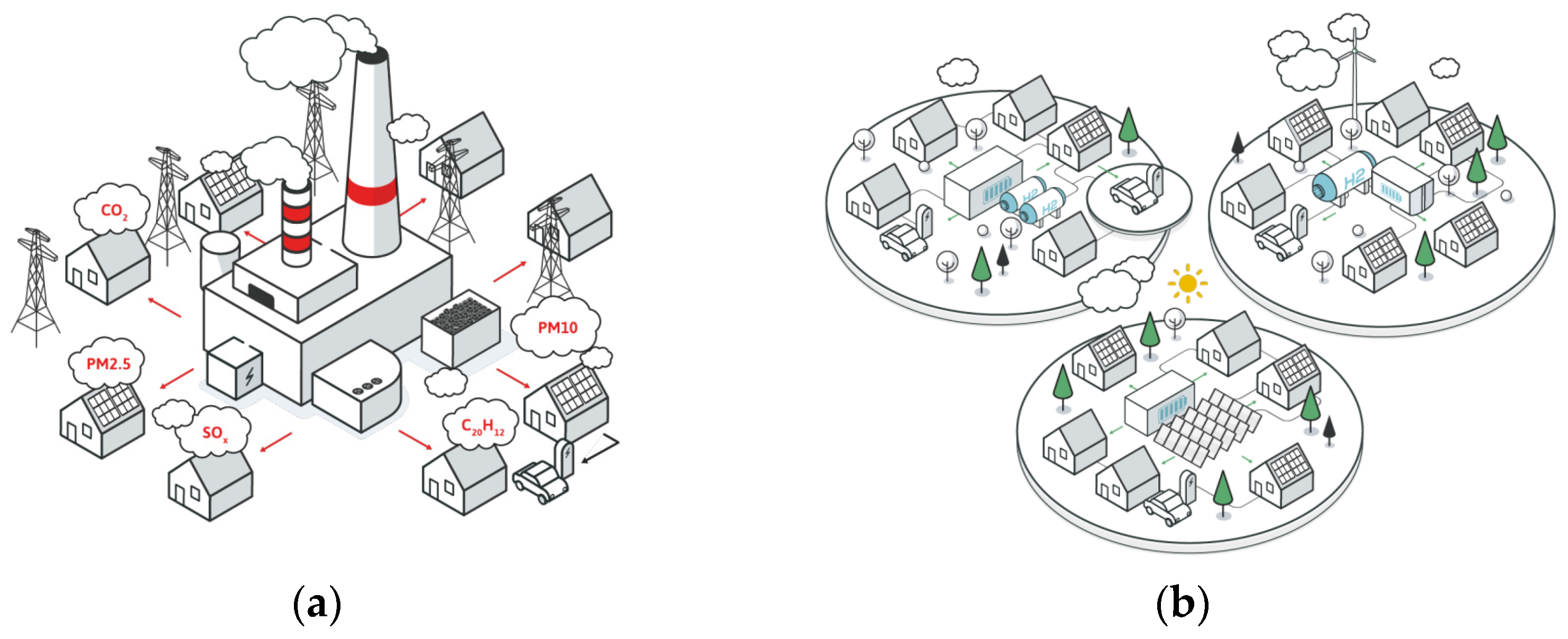
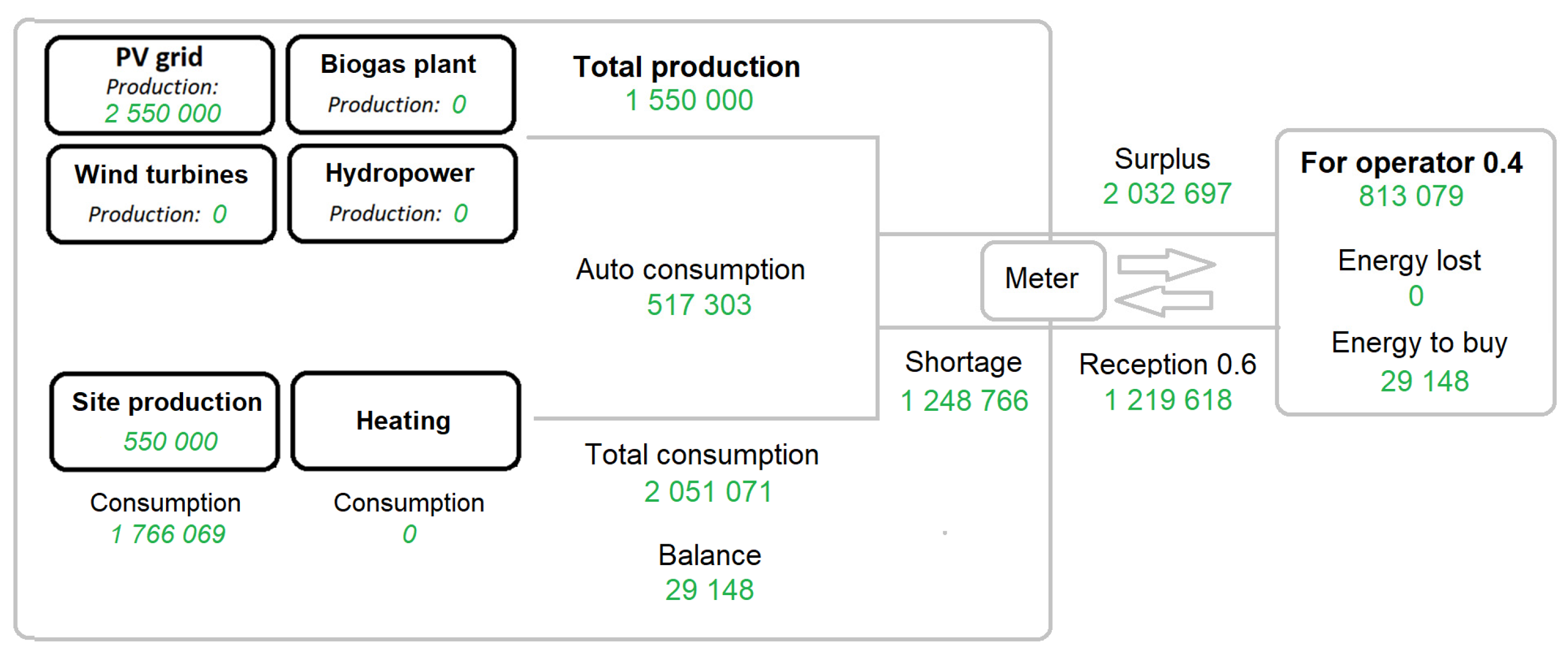
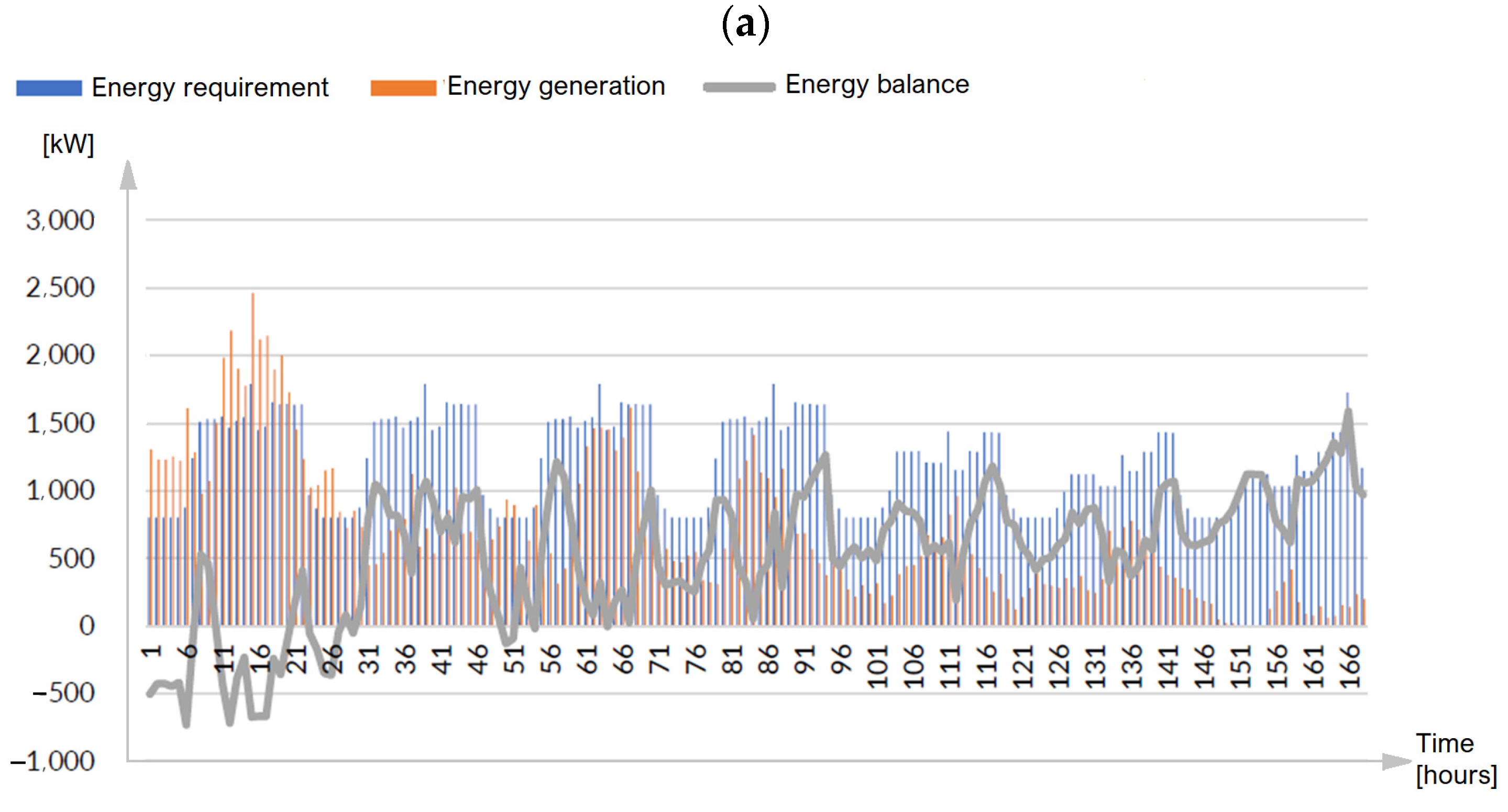
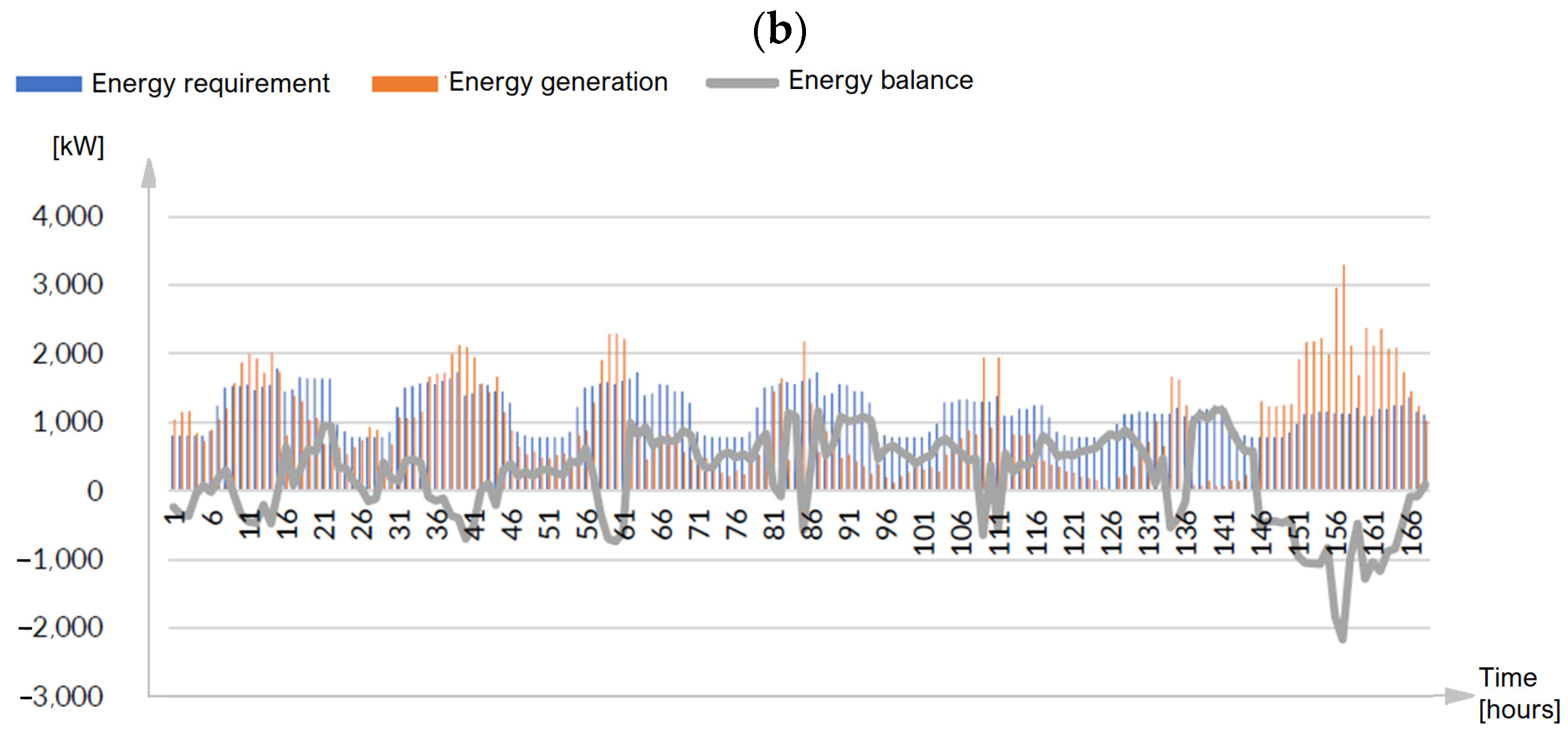
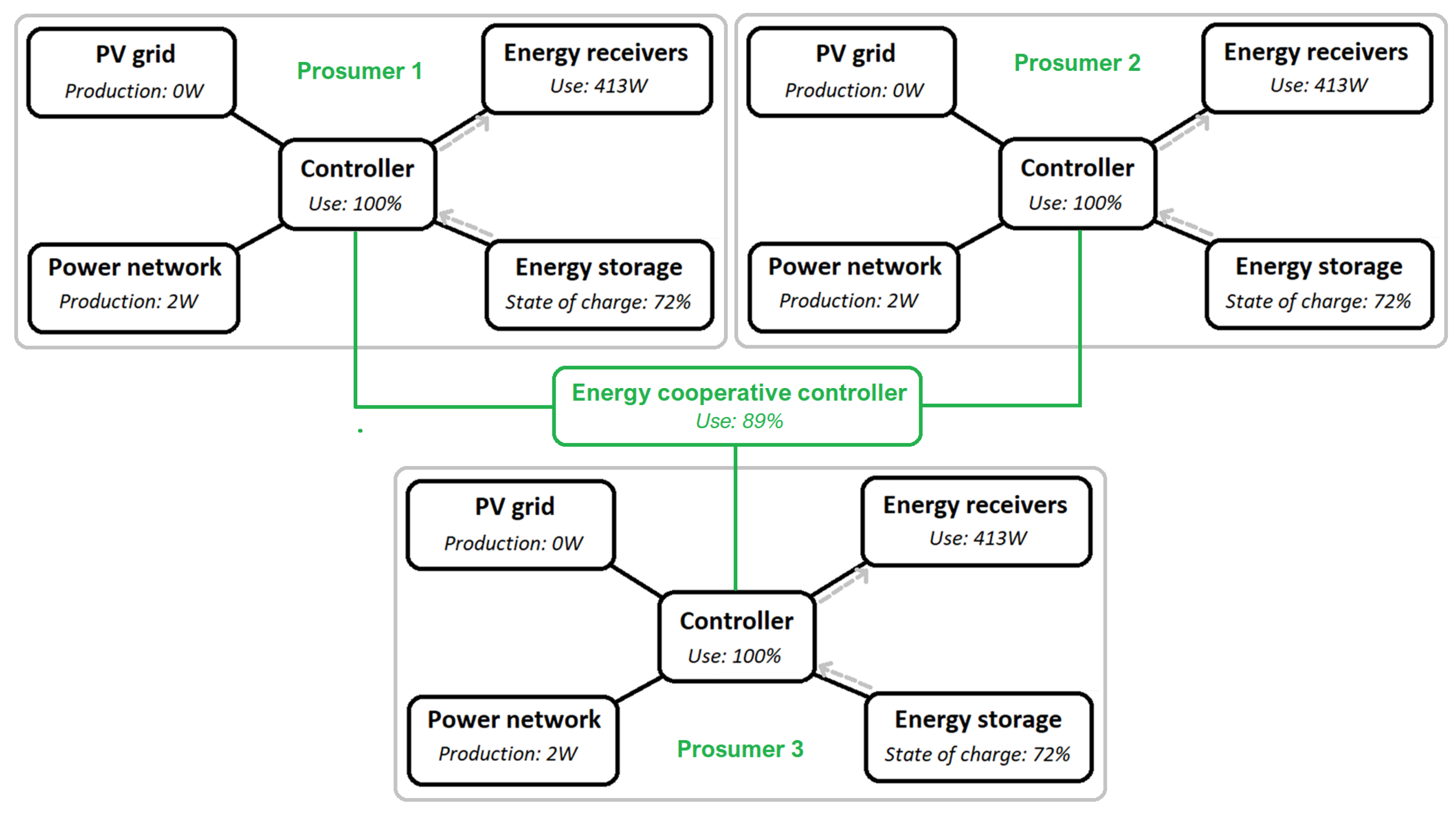
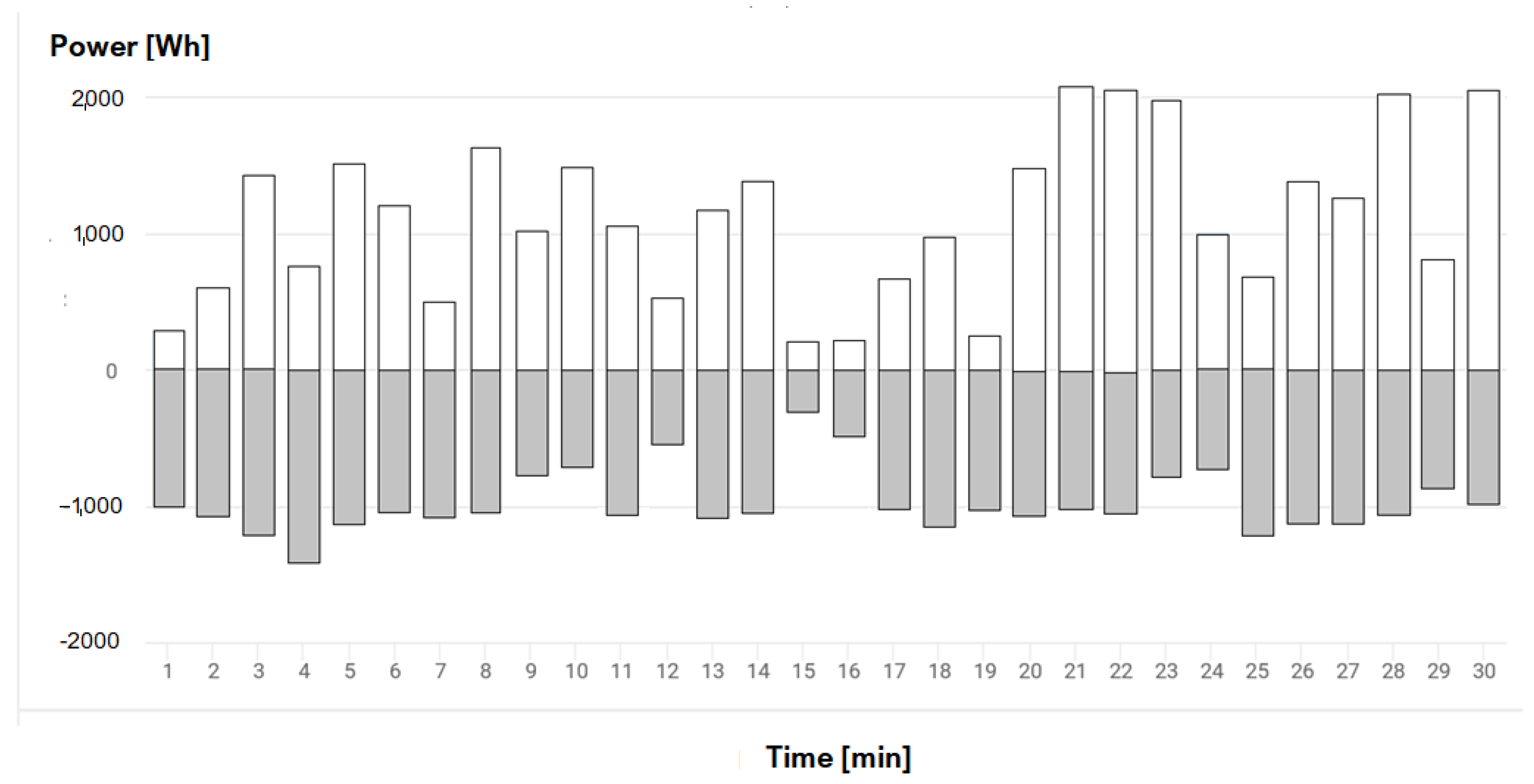

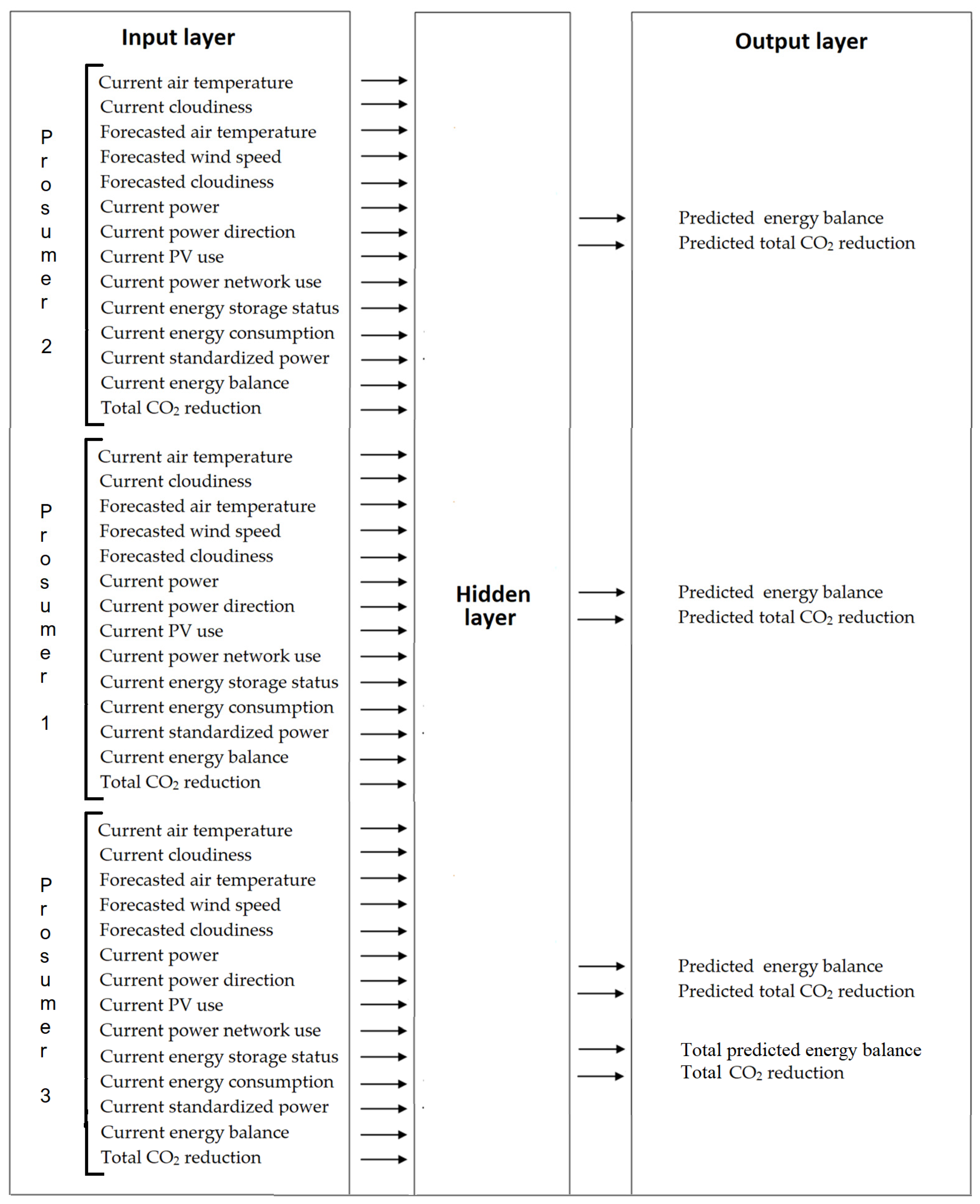
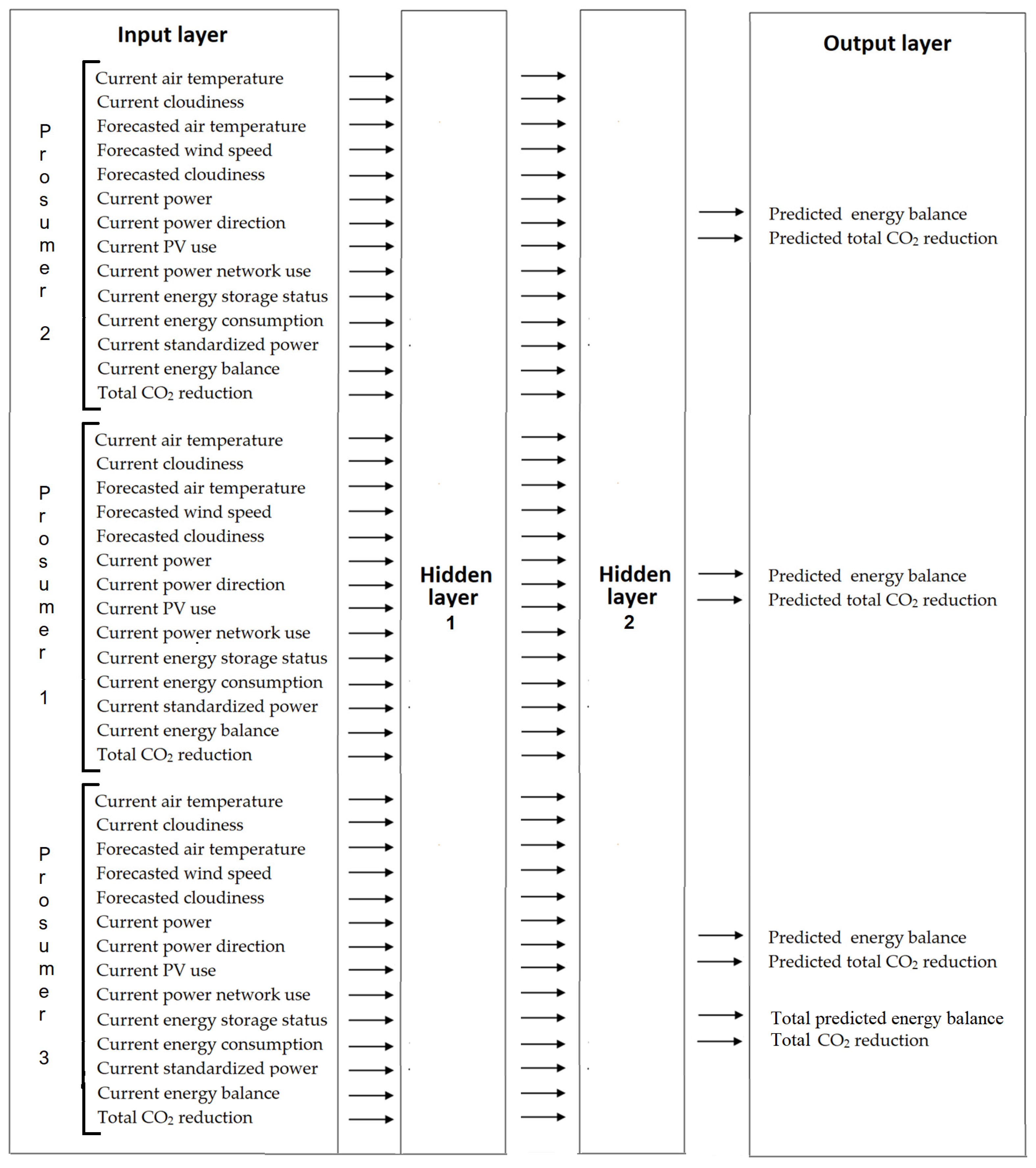
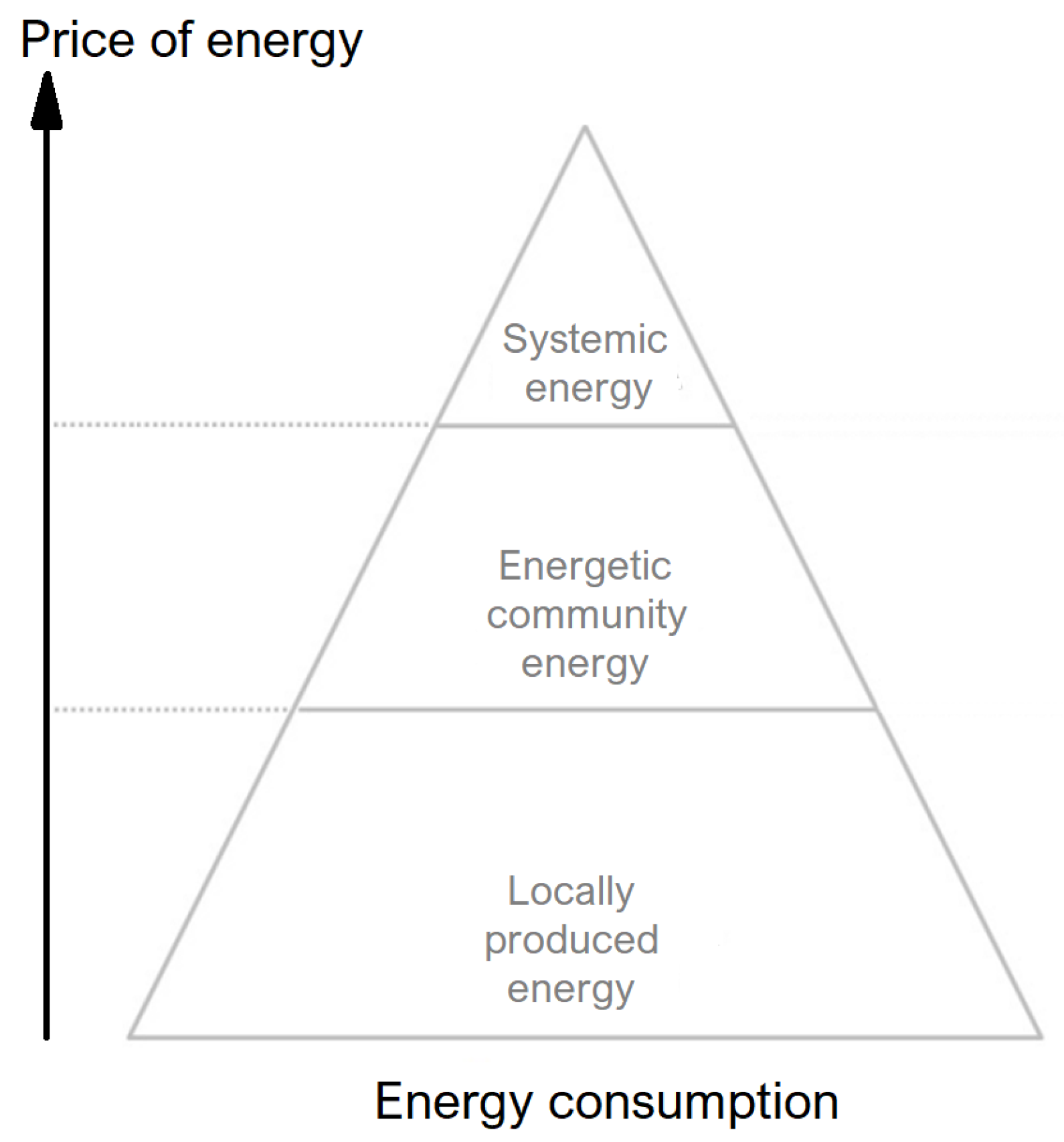
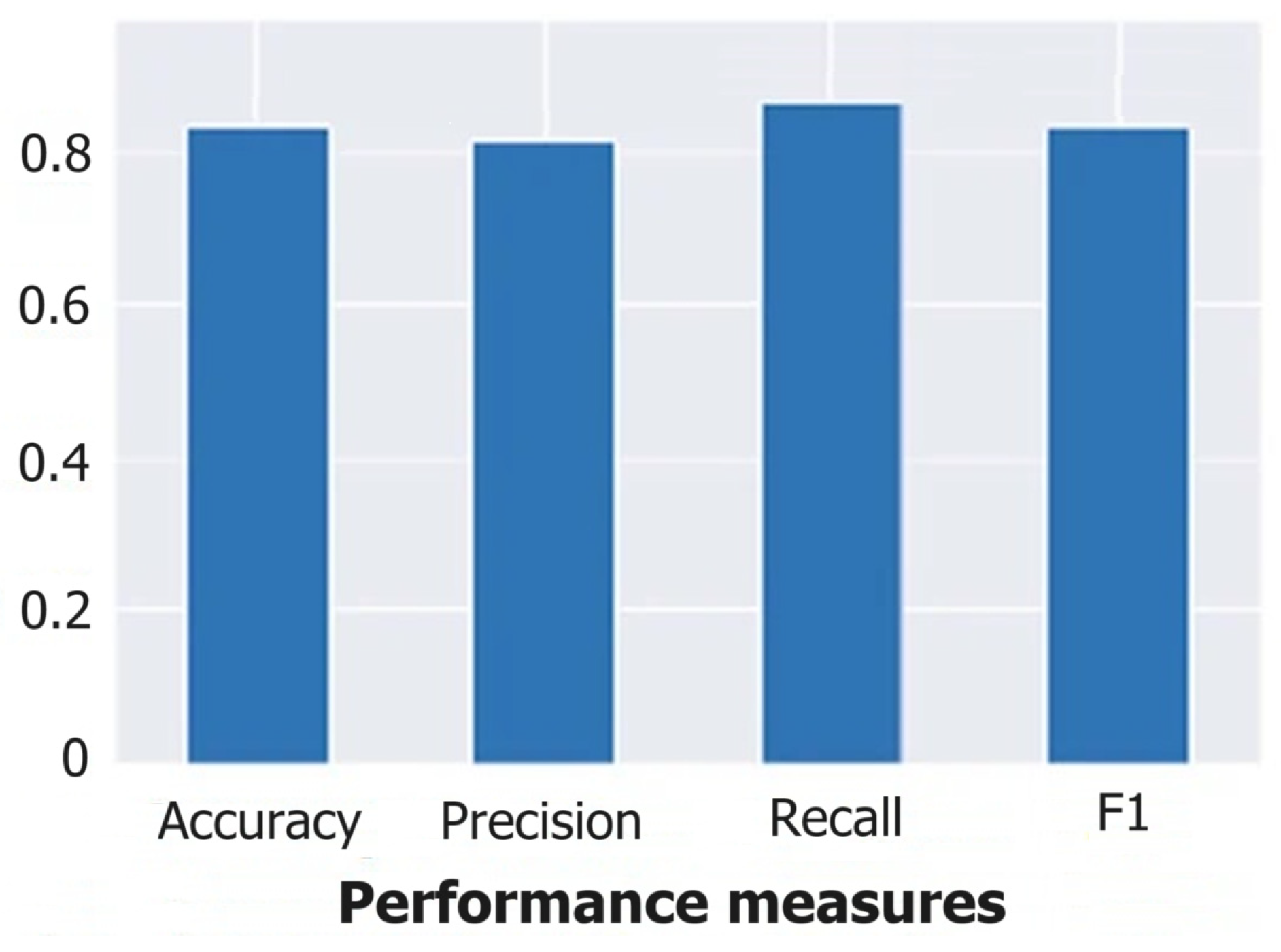
| Positive | Negative | |
|---|---|---|
| I n t e r n e l | Strengths Increasing adoption of renewable energy sources Technological advancements Reducing energy waste Decentralization Shared consciousness and responsibility | Weaknesses Required collaboration among governments, industries, and communities High initial costs (e.g., infrastructure) Intermittency Market fragmentation, hard to manage Regulatory problems hindering integration |
| E x t e r n a l | Opportunities Supporting innovations Lowering energy cost for consumers Carbon neutrality New jobs | Threats Economic challenges Vulnerabilities Geopolitical factors |
| Political Drivers | Economic Drivers | Geographical Drivers | Technological Drivers | Social Drivers |
|---|---|---|---|---|
| National and EU long-term strategies Milestones and targets concerning share of renewable energy in the total energy supply Agreement on indicators | Country/regional capacity and development Costs of renewable energy related to energy from traditional sources Subsidies, grants, etc. | Solar energy potential Wind speed Access to river/sea | Level of renewable technologies development R&D capacities Technical condition of grids Knowledge of experts | Awareness of energy prosumers and consumers Acceptance of possible higher cost of energy from renewable resources |
| Parameter | Mean | SD | Min | Q1 | Median | Q3 | Max |
|---|---|---|---|---|---|---|---|
| Prosumer 1 | |||||||
| Current air temperature (°C) | 14.31 | 4.76 | 7 | 11 | 14 | 17 | 21 |
| Current wind speed (m/s) | 4.87 | 1.01 | 0 | 2.25 | 4.50 | 5.24 | 6.32 |
| Forecasted air temperature (°C) | 15.21 | 5.11 | 7 | 12 | 16 | 18 | 25 |
| Forecasted wind speed (m/s) | 4.67 | 0.84 | 1 | 2.11 | 5.00 | 7.33 | 11.11 |
| Power (Watt) | 18.42 | 5.23 | 11.37 | 13.91 | 17.26 | 19.11 | 21.45 |
| Total CO2 reduction (tons) | 10.43 | ||||||
| Prosumer 2 | |||||||
| Current air temperature (°C) | 15.27 | 5.32 | 7 | 11 | 14 | 17 | 22 |
| Current wind speed (m/s) | 4.39 | 1.07 | 0 | 2.50 | 5 | 5.25 | 6.79 |
| Forecasted air temperature (°C) | 15.98 | 5.44 | 7 | 12 | 16 | 20 | 25 |
| Forecasted wind speed (m/s) | 5.08 | 1.13 | 1 | 2.12 | 5.13 | 7.67 | 12.89 |
| Power (Watt) | 16.97 | 4.61 | 12.52 | 14.16 | 16.43 | 18.56 | 21.22 |
| Total CO2 reduction (tons) | 10.38 | ||||||
| Prosumer 3 | |||||||
| Current air temperature (°C) | 16.07 | 5.38 | 7 | 11 | 14 | 17 | 22 |
| Current wind speed (m/s) | 4.96 | 1.11 | 0 | 2.25 | 4.50 | 5.24 | 6.32 |
| Forecasted air temperature (°C) | 16.11 | 5.34 | 8 | 13 | 17 | 21 | 24 |
| Forecasted wind speed (m/s) | 5.07 | 1.24 | 0 | 2.13 | 5.08 | 6.22 | 10.87 |
| Power (Watt) | 18.49 | 4.56 | 11.40 | 13.99 | 17.35 | 20.07 | 22.41 |
| Total CO2 reduction (tons) | 10.32 | ||||||
| Traditional Artificial Intelligence (Decision Trees, Random Forests, etc.) | Traditionalmachine Learning | Deep Learning | Fuzzy Logic | Fractal Analysis |
|---|---|---|---|---|
| Classification | Classification Prediction | Classification Prediction | Trend analysis Direction of changes analysis | Smoothness analysis Analysis of the possibility of changing the trend |
| Hyperparameter | Description |
|---|---|
| Number of hidden layers | Searching for the best performing architecture |
| Activation function(s) | Selection of activation functions for each layer in a way that maximizes model performance |
| Weight initialization | Experiments with different weight initialization methods, which may affect network learning |
| Learning rate value | Finding an appropriate learning rate to ensure learning converges without overshooting or getting stuck in local minima |
| Learning rate schedule | Adjusting the learning rate of the network using its schedules |
| Batch size | Batch size controls the number of training samples used in each update of the model weights (too small batches result in greater spread, and large batches result in slower convergence) |
| Number of epochs | After how many epochs to stop training to prevent overfitting |
| Regularization techniques | Tuning the strength of regularization prevents over-tuning |
| Optimization | Experimental adjustment of the optimizer that best suits the problem at hand, positively affecting the learning speed and convergence of the network |
| Stage of the Procedure | Description |
|---|---|
| Feature analysis | Understanding the nature of the data set and the extent to which it influences the final result |
| Feature engineering | Transforming existing features or creating new features to improve the model’s ability to capture patterns in the data |
| Feature selection | Dimensionality reduction through selection or elimination |
| Cross-validation | Compartment of the performance of different feature sets and hyperparameter configurations to prevent overfitting |
| Iterative tuning | Continuous repetition of procedures until the most effective model is found in the analysis of validation data |
| Model | Accurracy (Learning) [%] | Accurracy (Testing) [%] | RMSE |
|---|---|---|---|
| MLP 42-60-8 | 85.33 | 86.81 | 0.001 |
| CNN 42-50-50-8 | 83.22 | 85.37 | 0.002 |
| Support Vector Regression (SVR) * | 81.11 | 82.78 | 0.01 |
| eXtreme Gradient Boosting (XGBoost) | 77.22 | 78.96 | 0.02 |
| Polynomial regression | Spearmann’s Rho 0.699 (p < 0.05) | ||
| ANN Structure | Activation Function in the Hidden Layer | Activation Function in the Output Layer | Accuracy (Learning) [%] | Accuracy (Testing) [%] | RMSE |
|---|---|---|---|---|---|
| MLP 42-46-8 | Sigmoid | Sigmoid | 81.13 | 82.43 | 0.02 |
| MLP 42-52-8 | Sigmoid | Sigmoid | 83.46 | 84.26 | 0.01 |
| MLP 42-60-8 | Sigmoid | Sigmoid | 85.33 | 86.81 | 0.001 |
| MLP 42-66-8 | Sigmoid | Sigmoid | 83.36 | 84.12 | 0.01 |
| MLP 42-72-8 | Sigmoid | Sigmoid | 80.95 | 82.21 | 0.02 |
| Positive | Negative | |
|---|---|---|
| I n t e r n e l | Strengths Increased data analytics Energy forecasting Optimization of energy generation, distribution, and consumption Predictive maintenance | Weaknesses Integration challenges AI complexity Algorithm bias Data privacy |
| E x t e r n a l | Opportunities Carbon emissions reduction Improved energy trading Integration of renewable energy sources into the grids Advanced mart grids technologies | Threats Regulatory challenges Cybersecurity risks AI reliability during critical energy decisions Low societal awareness |
| Limitation | Detailed Description |
|---|---|
| Data quality and availability | The energy sector can have limitations in terms of data quality, consistency and availability, and inaccurate or incomplete data can lead to unreliable AI-based decisions. |
| High complexity of energy systems (especially distributed renewable energy systems) | Complex systems with different stakeholders, regulatory constraints, and dynamic interactions can be reflected by AI models with oversimplifications, leading to inaccurate predictions. |
| Uncertainty of the energy transition in an environment of evolving policies, new technologies and high energy market dynamics | Rapid changes in areas of government policy and regulation can disrupt AI-based strategies, require too frequent model updates and make it difficult to select the best models. |
| High upfront costs | Implementing AI solutions in the energy sector can be costly, requiring investment in technology, workforce preparation and infrastructure, and smaller organizations and regions may face barriers to entry here. |
| Challenges related to the required upgrade or replacement of energy infrastructure | Transforming energy markets may require significant changes to infrastructure, but their AI-based optimization may be hampered by physical and logistical challenges. |
| Threats in the area of cyber security | Malicious actors can attack AI systems to disrupt energy supplies or gain unauthorized access to sensitive data. |
| Resistance to change, including the threat of job loss/change | Implementing AI-based transformations can face resistance from stakeholders who are used to traditional approaches or skeptical of new technologies. |
| Direction of Further Research | Detailed Tasks and Activities |
|---|---|
| Integration of renewable energy sources into the grid | Develop AI models and algorithms to facilitate the seamless integration of renewable energy sources (e.g., solar, wind) into the grid and to predict and manage intermittency, optimize energy storage, and demand management. |
| AI-based optimization of the energy market structures | Optimization of energy market structures should include pricing mechanisms, trading platforms and capacity markets to encourage the use of renewable energy and ensure grid stability. |
| Resilience of energy grids against physical and cyber threats | These activities include the development of predictive maintenance models, real-time monitoring, and adaptive network control. |
| Improving energy efficiency in various sectors | Sectors such as manufacturing, transport, and buildings should be subject to examining and optimizing the impact of energy efficiency on reducing emissions and energy costs. |
| Role of AI in managing decentralized energy systems | Microgrids and DER should enable energy production and consumption to be as local as possible. |
| Forecasting of energy use and carbon emission reduction | Improving AI-based energy forecasting models to more accurately predict energy demand and supply, taking into account weather patterns, consumer behavior, and new technologies. |
| Exploring AI strategies to optimize energy consumption patterns to reduce carbon emissions: demand response, predictive analysis to reduce emissions, and carbon footprint tracking. | |
| AI explainability and accountability | Ensuring that stakeholders can understand and trust AI-based decisions. |
Disclaimer/Publisher’s Note: The statements, opinions and data contained in all publications are solely those of the individual author(s) and contributor(s) and not of MDPI and/or the editor(s). MDPI and/or the editor(s) disclaim responsibility for any injury to people or property resulting from any ideas, methods, instructions or products referred to in the content. |
© 2023 by the authors. Licensee MDPI, Basel, Switzerland. This article is an open access article distributed under the terms and conditions of the Creative Commons Attribution (CC BY) license (https://creativecommons.org/licenses/by/4.0/).
Share and Cite
Rojek, I.; Mroziński, A.; Kotlarz, P.; Macko, M.; Mikołajewski, D. AI-Based Computational Model in Sustainable Transformation of Energy Markets. Energies 2023, 16, 8059. https://doi.org/10.3390/en16248059
Rojek I, Mroziński A, Kotlarz P, Macko M, Mikołajewski D. AI-Based Computational Model in Sustainable Transformation of Energy Markets. Energies. 2023; 16(24):8059. https://doi.org/10.3390/en16248059
Chicago/Turabian StyleRojek, Izabela, Adam Mroziński, Piotr Kotlarz, Marek Macko, and Dariusz Mikołajewski. 2023. "AI-Based Computational Model in Sustainable Transformation of Energy Markets" Energies 16, no. 24: 8059. https://doi.org/10.3390/en16248059
APA StyleRojek, I., Mroziński, A., Kotlarz, P., Macko, M., & Mikołajewski, D. (2023). AI-Based Computational Model in Sustainable Transformation of Energy Markets. Energies, 16(24), 8059. https://doi.org/10.3390/en16248059








